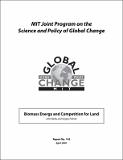Biomass Energy and Competition for Land
Author(s)
Reilly, John; Paltsev, Sergey
DownloadMITJPSPGC_Rpt145.pdf (1.301Mb)
Metadata
Show full item recordAbstract
We describe an approach for incorporating biomass energy production and competition for land into the MIT Emissions Prediction and Policy Analysis (EPPA) model, a computable general equilibrium model of the world economy, that has been widely used to study climate change policy. We examine multiple scenarios where greenhouse gas emissions are abated or not. The global increase in biomass energy use in a reference scenario (without climate change policy) is about 30 EJ/year by 2050 and about 180 EJ/year by 2100. This deployment is driven primarily by a world oil price that in the year 2100 is over 4.5 times the price in the year 2000. In the scenarios of stabilization of greenhouse gas concentrations, the global biomass energy production increases to 50-150 EJ/year by 2050 and 220-250 EJ/year by 2100. The estimated area of land required to produce 180-250 EJ/year is about 2Gha, which is an equivalent of the current global crop area. In the USA we find that under a stringent climate policy biofuels could supply about 55% of USA liquid fuel demand, but if the biofuels were produced domestically the USA would turn from a substantial net exporter of agricultural goods ($20 billion) to a large net importer ($80 billion). The general conclusion is that the scale of energy use in the USA and the world relative to biomass potential is so large that a biofuel industry that was supplying a substantial share of liquid fuel demand would have very significant effects on land use and conventional agricultural markets.
Description
Abstract in HTML and technical report in PDF available on the Massachusetts Institute of Technology Joint Program on the Science and Policy of Global Change website (http://mit.edu/globalchange/www/).
Date issued
2007-04Publisher
MIT Joint Program on the Science and Policy of Global Change
Citation
Report no. 145
Series/Report no.
Report no. 145